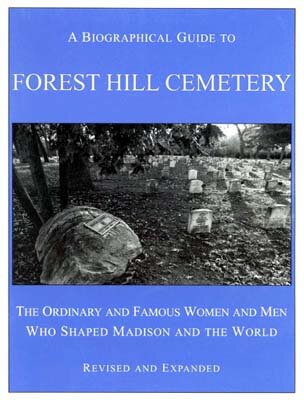A Biographical Guide to Forest Hill Cemetery: The Ordinary and Famous Women and Men Who Shaped Madison and the World
Researched and written by the Forest Hill Cemetery Committee of HMI
[from "Introduction and Notes"] "This book, a companion to HMI's brochure Forest Hill Cemetery - A Walking Tour, contains biographical sketches about many of our departed citizens. These sketches include not just the dates and events that defined their lives, but anecdotes that offer a glimpse into their personalities and characters as well. The approximate burial site of each individual included in this guide is shown on the map that accompanies this book.
"Forest Hill is the final (and in some cases, third) resting place for many Madisonians who have made our city, state and world special. An inordinate number of remarkable individuals are buried here: Stephen M. Babcock, inventor of the butterfat test that made the modern dairy industry possible; John Bardeen, winner of two Nobel Prizes, one for the invention of the transistor and the other for the discovery of superconductivity; Kay Clarenbach, one of the nation's leading feminists; Richard T. Ely, the dean of American economics; the LaFollettes, Wisconsin's dominant political family for over half a century; Harry Steenbock, discoverer of vitamin D; Howard Temin, Nobel laureate in retrovirology; Frederick Jackson Turner, the most influential historian of his generation; and Edwin E. Witte, one of the fathers of Social Security.
"Many others are equally fascinating. Edward Birge, inventory of the science of limnology; Ebeneezer Brigham, the first white settler of Dane County; Charles E. Brown, archaeologist and preserver of effigy mounds; Lyman Copeland Draper, collector of memorabilia about early western pioneers; Henry Baird Favill, whose Wisconsin roots stretch back to the 1600s; Carson Gulley, Wisconsin's best-known chef; Henry Harden, captor of Confederate president Jefferson Davis; the Jefferson family, descendents of the United States' third president; John Olin, the father of Madison's park system; Halle Steensland, vice consul to Norway and Sweden; Rabbi Manfred Swarsensky, one of Madison's leading religious figures; William Freeman Vilas, postmaster general and Secretary of the Interior; and a host of governors, U.S. Senators, Supreme Court justices, and university presidents.
"And there are veterans of the War of 1812, the head waiter from the Buchanan White House, a husband and wife killed on the railroad tracks over Lake Monona 20 years apart, the first white child born in Iowa, a business partner of abolitionist John Brown, an African American who played football for Madison High School against the UW in the 1890s, the songwriter of "Tippecanoe and Tyler, Too," Confederate prisoners of war, the inventor of peanut brittle, a Deadwood stage driver, and countless others.
"The Madison of 2002 bears little resemblance to the paper city that was voted the capital of Wisconsin Territory in November, 1836. That isolated town site was inhabited by a handful of Ho-Chunk families, covered with prairie, and rich with effigy mounds. Today it is a densely-populated city of tall buildings, congested highways, and numerous suburbs that continues to expand outward from its historic heart, gobbling more and more of Dane County's prime farmland in the process. The story of how Madison was transformed from pastoral to urban, and how its physical appearance and institutions came to be, is actually the stories of the thousands of Madisonians who shaped our city, day by day, year by year. In a real sense, it is by remembering who they were and what they did that we can begin to understand why Madison is the way it is."
Chapters: Founders (includes capitol workers and later first arrivals), Shapers (architects, MP&PDA), Heart of the City (King Street, State Street, Capitol square), Lakes (water deaths), ties to signers of the Declaration of Independence, Giants of the city, African Americans, Jewish, Politicians (governors, House of Representatives, mayors, U.S. Senate, WI Supreme Court), University faculty, WI Historical Society staff, War (War of 1812, War with Mexico, Civil War, Spanish-American War, World War I and the flu epidemic, World War II, Korean War, Vietnam), Farmers, Law (attorneys, district attorneys, judges), Medicine, News, Athletics, Church men, and the Ordinary and Famous.
While we were collecting final quotes on the Forest Hill Cemetery book project, we began writing grant applications to help defray some of our costs so we could keep the book price affordable in the stores. We were fortunate enough to receive a $5000 grant from the Evjue Foundation towards the printing costs. We want to thank them for their support.
Published 2002, ISBN 0-9728665-0-7, 2-book set, 624 pages, illustrated, indexed, $14.00

